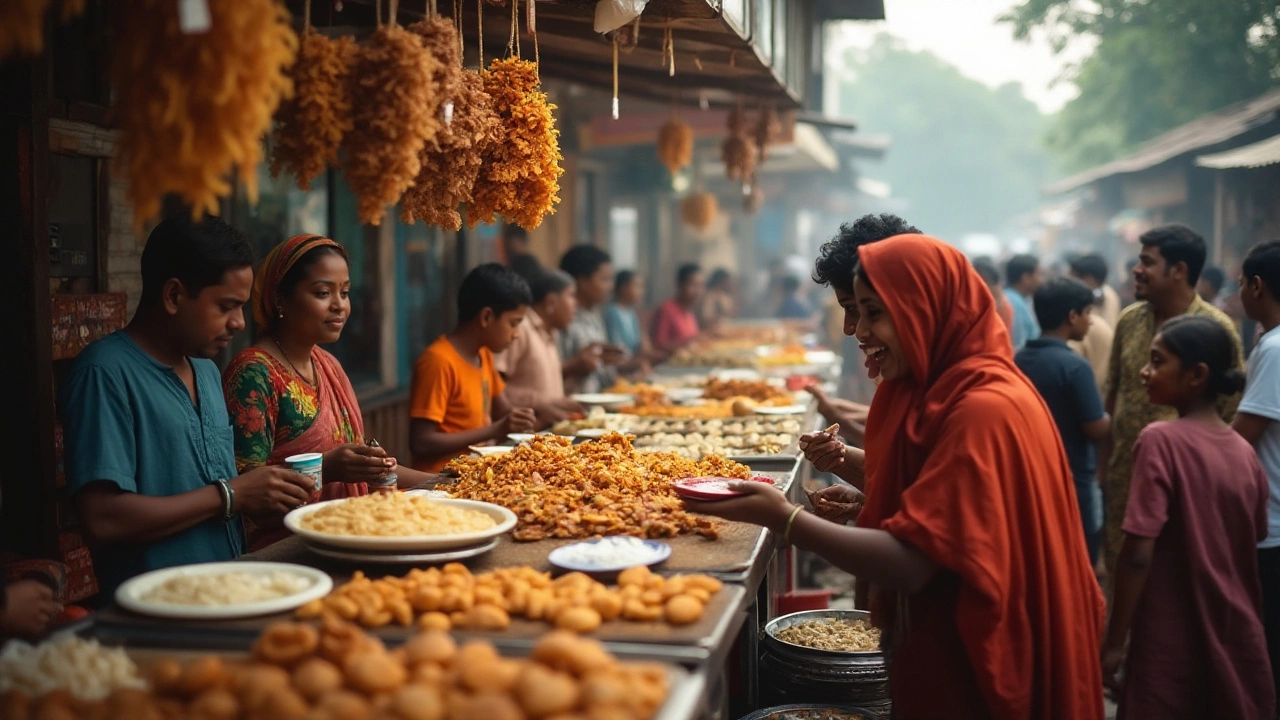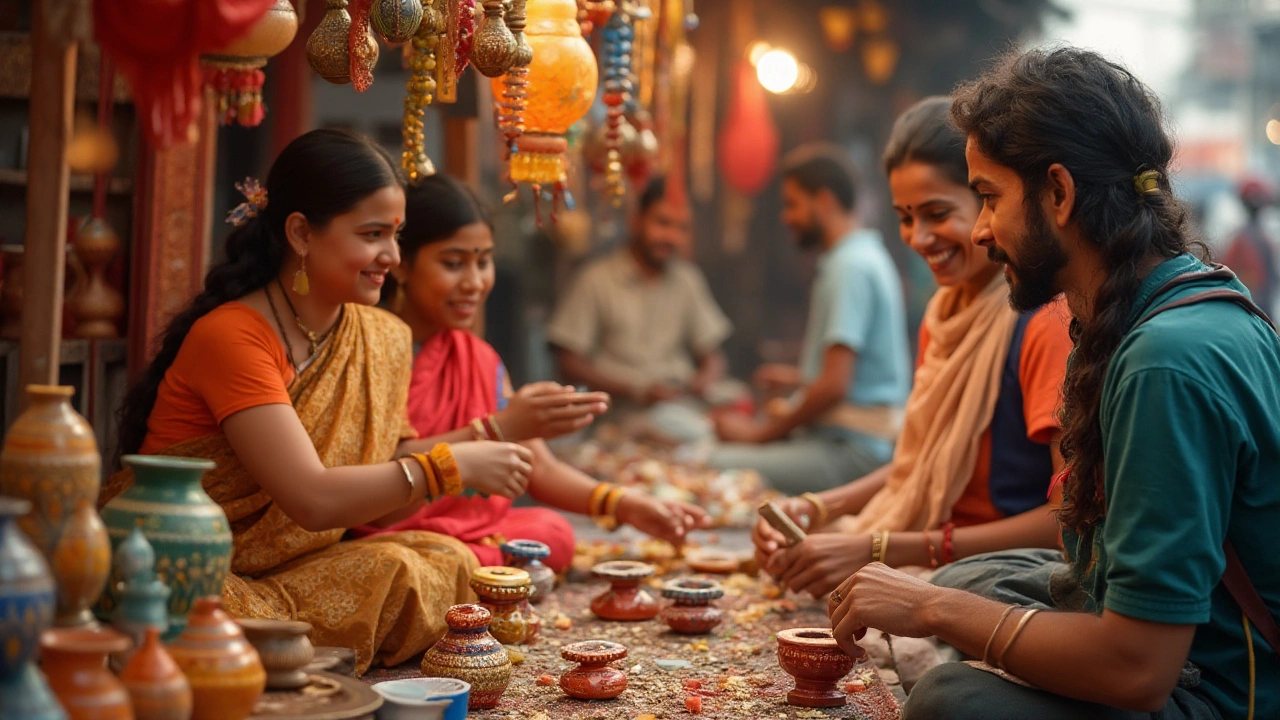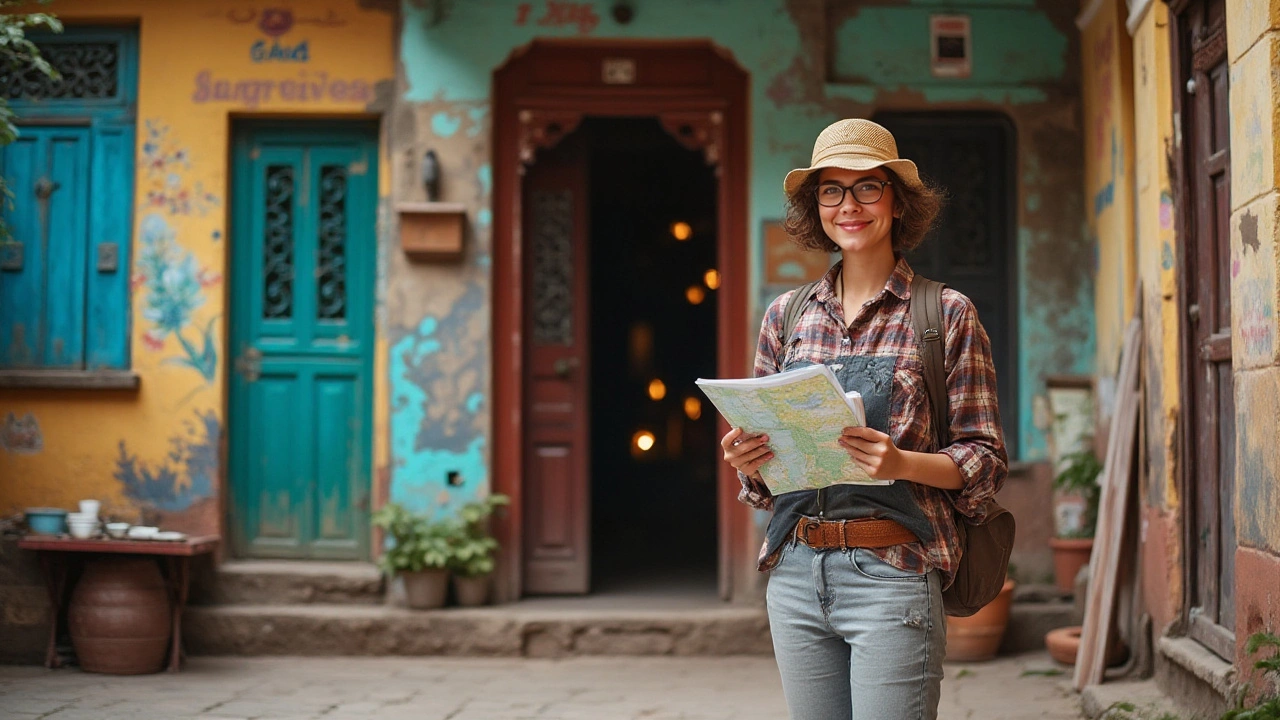Embarking on a journey to India with a modest budget can be both thrilling and rewarding. For travelers clutching 10,000 rupees, it's essential to gauge how far these notes will carry you through the vibrant and diverse landscapes.
The first step is to familiarize yourself with the conversion rates and local costs, which can vary dramatically from region to region. Whether you are navigating bustling city streets or exploring tranquil countryside spots, knowing where and how to spend can significantly enhance your experience.
From securing cozy accommodations to indulging in delectable yet affordable culinary delights, every penny holds the potential to create memorable adventures.
With the right knowledge and a little bit of planning, you can uncover countless opportunities to enjoy India without stretching your wallet too thin.
- Understanding Currency Conversion
- Accommodations on a Budget
- Affordable Dining Options
- Experiences Beyond Traditional Sightseeing
Understanding Currency Conversion
When setting off on an adventure to India with an eye on your bank balance, grasping the concept of currency conversion becomes your first stride towards becoming a savvy traveler. India's vibrant economy and rich culture, juxtaposed with the humility of its currency, open up a world of affordability and opportunity. For those with 10,000 rupees in hand, it's akin to holding a treasure chest that, with smart planning, could lead to an unforgettable experience across this diverse landscape.
The Indian rupee (INR), symbolized by ₹, is a fascinating currency. Though its value against popular Western currencies like the USD and Euro fluctuates, it has historically provided an appealing conversion rate for foreign travelers. As of the last couple of years, one US dollar has equated to around 74 to 83 rupees, depending on economic factors. This means that the 10,000 rupees you carry could equate to approximately 120 to 135 US dollars, permitting travelers to stretch their budget further if they play their cards right.
Why Currency Conversion Matters
Understanding currency conversion is not merely about arithmetic; it involves understanding the purchasing power carried by those pieces of paper in your wallet. Because costs of goods and services can vary widely across the nation, knowing how far your money will go is crucial in planning your daily expenses. In bustling metropolises like Mumbai or Delhi, the cost of living tends to be steeper compared to serene towns or rural villages. A meal in a local street market could cost anywhere from 100 to 300 rupees, while dining in a premium location might set you back significantly more.
The South, known for its tech-savvy cities like Bengaluru, yet harbors rustic villages where life carries on at a more relaxed, budget-friendly pace. This is where understanding currency conversion helps shape a robust travel itinerary. As an example, if you're keen on experiencing Indian culture at its roots, venturing into smaller towns or states like Rajasthan or Kerala can provide enriching experiences with much lower expenses, amplifying your purchasing power immensely.
"Currency is the mother of social interaction for any traveler. It's the invisible thread upon which the quality of experience is hung," notes noted travel economist, Dr. Priya Verma, illustrating how a simple understanding can elevate one's travel escapade.
Engaging with locals, many of whom have a sharp eye for currency rates, can further facilitate your understanding of conversions and help avoid overspending. Additionally, utilizing digital banking apps that showcase real-time rates and financial trends becomes an indispensable tool in maintaining an efficient budget. Exchange rates might also favor purchasing larger quantities or booking accommodations directly through Indian contacts.
An Opportunity with Exchange Rates
| Currency | Exchange Rate (INR to 1 unit) |
|---|---|
| USD | 83 |
| EUR | 91 |
| GBP | 104 |
For an astute traveler, exchange rates present a window of opportunity that should not be overlooked. Waiting until the rupee dips slightly in value can vastly alter your travel story, enabling those 10,000 rupees to unlock experiences otherwise out of reach. Always keeping abreast with recent trends through accessible online tools or financial news aggregators ensures you not only make informed decisions as a traveler but also as a budding economist.
To wrap it up, understanding India’s currency conversion is a subtle art form, blending historical awareness with forward-thinking anticipation. While it might seem daunting initially, immersing oneself in its intricacies rewards travelers with a journey that is prudent yet immensely rich and fulfilling.

Accommodations on a Budget
Exploring India's vast and culturally rich landscape on a budget doesn't mean you have to compromise on comfort. The country boasts a wide array of accommodation options suitable for every traveler's pocket. When it comes to budget lodging, options range from youth hostels to homestays and guesthouses. Many international backpackers and seasoned explorers swear by the charm and community vibe of budget travel India. Hostels, in particular, not only provide dormitory style living but often offer private rooms for a slightly higher fee, which can still be very affordable.
A popular choice among budget travelers is Zostel, India’s first and largest chain of backpacker hostels. Zostels are scattered across the country in prime locations, maintaining a uniform standard of cleanliness and hospitality. Price per night generally ranges from 300 to 1,500 rupees, depending on the level of privacy and location you prefer. Indian currency can stretch a long way if spent wisely, allowing you to save on accommodations and splurge a bit more on experiences.
Another enticing accommodation option is homestays. This provides a unique opportunity to immerse yourself in the local culture, as you live with a host family. Websites like Airbnb list numerous desirable options, ranging from hilly retreats to city apartments at competitive prices. Beyond simply providing a bed, these lodgings offer home-cooked meals which can deepen your cultural experience. And for those looking for more remote options, organizations like Workaway offer work exchange programs with free board and meals in exchange for a few hours of work each day.
"We loved our stay at a homestay in Kerala. The hospitality was unmatched, and the food was as genuine as the smiles that served it." - Lonely Planet review.
For travelers looking to delve into India’s vibrant cities, guesthouses or affordable hotels may tick all the right boxes. It’s worth keeping an eye on local booking platforms like Oyo Rooms, which cater specifically to budget-conscious travelers. These rooms often include amenities like Wi-Fi, breakfast, and sometimes even air conditioning, all at a competitive rate. Due to regional price differences, northern cities like Jaipur often offer cheaper lodging compared to the metropolitan hubs such as Mumbai or Delhi.
To stretch your rupees further, consider traveling during the off-peak seasons. Tourism declines during the intense summer months or monsoon, consequently driving accommodation prices down significantly. If you are flexible with your travel schedule, this may afford you the opportunity to indulge in luxury stays that might otherwise be overbearing on your budget.
Comparing Costs in Major Cities
| City | Average Nightly Cost (Rupees) |
|---|---|
| Delhi | 1,000 - 3,000 |
| Mumbai | 1,500 - 4,500 |
| Jaipur | 500 - 2,000 |
| Goa | 700 - 2,500 |
Of course, every traveler’s expectations and needs vary. So whether you are yearning for the communal vibe of a hostel, the personal touch of a homestay, or the reliability of a small budget hotel, always remember that each city and region offers something unique. A bit of preparation and local insight can ensure your stay is both affordable and enriching.

Affordable Dining Options
Exploring India's vibrant culinary landscape is one of the most thrilling aspects of traveling on a budget. The country is a paradise for food lovers, offering a myriad of flavors that reflect its diverse culture. Street food reigns supreme when it comes to affordable dining options in India. You can savor a plate of spicy pav bhaji or indulge in a crisp dosa for just a few rupees. Sampling these dishes not only keeps your expenses in check but also guarantees an authentic taste of Indian cuisine.
As you wander through bustling marketplaces, the aroma of samosas, chaat, and pakoras is often irresistible. Known for their bold flavors and generous spices, these snacks are found almost everywhere, from local carts to small eateries. Beyond just street fare, many dhabas (roadside restaurants) offer hearty meals that won't dent your budget. These establishments often serve thalis, a platter featuring various traditional dishes, providing a complete meal at one fixed, economical price.
In urban cities like Delhi and Mumbai, budget travelers can also explore small cafeterias or eateries that offer local delicacies at affordable prices. While in Delhi, a stop at Paranthe Wali Gali in Chandni Chowk can result in not just a delightful meal of stuffed parathas but also a cultural immersion. These meals are fresh, flavorful, and fill travelers with a unique dining experience without breaking their budget travel India efforts.
Local and Seasonal Saves
A savvy way to keep your food expenses in check while traveling in India is to focus on local and seasonal ingredients. By choosing dishes made with in-season produce, you can ensure lower prices and greater quality. Markets brimming with fresh fruits and vegetables are a common sight in India, and buying directly from these vendors is often cheaper than dining out. This approach not only preserves your budget but also allows you to eat healthier during your travels.According to renowned food critic Vir Sanghvi, "India's street food culture is among the best ways to experience its regional diversity. From the spiced goodness of vada pav in Mumbai to the sweet delight of lassi in Punjab, there's a culinary treasure to be found in every corner."The key is to embrace the local rhythm and flavor at every stop. As a bonus, purchasing food from these vendors often contributes directly to local economies, making it both an ethical and economic choice.
Dining Tips for the Savvy Traveler
When it comes to eating out, a few strategic decisions can help you stretch those rupees further. Always look for places filled with locals, as they often know best when it comes to flavor and price. Be observant of how popular each stall or small restaurant is, as this is generally a good indicator of quality and safety. Asking locals for recommendations is another fantastic way to discover hidden culinary gems that might not appear in guidebooks.Remember, water served at eateries may not be filtered, so prioritize bottled water to avoid any health pitfalls. Additionally, despite the affordability of Indian currency dishes, sticking to local brands and avoiding imported items can further extend your budget. Cooking occasionally while on the go, especially if you have access to a small kitchen at your accommodation, lets you experience local markets while also managing your food budget effectively.
In summary, eating deliciously and economically in India is always possible with the right choices. By indulging in local street food, focusing on seasonal dishes, and adhering to some practical tips, your 10,000 rupees will truly provide a culinary journey worth every bit.

Experiences Beyond Traditional Sightseeing
India is a treasure trove filled with unique experiences that go beyond the common tourist trails. While iconic sites like the Taj Mahal and Jaipur's palaces attract hordes of visitors, there exists an equally captivating world that resides beyond the bounds of typical sightseeing. Engaging in these lesser-known experiences can deepen your appreciation for the country's diverse cultures and traditions. One such opportunity lies in visiting the sprawling tea estates of Assam and Darjeeling, where you can immerse yourself in the serene beauty of verdant plantations while learning about the intricate art of tea cultivation. Participating in a tea-tasting session here could provide an insight into the flavors that have captivated the world for centuries.
Another captivating escape takes you to the vibrant festivals celebrated across the nation. India's calendar is packed with colorful and lively festivals, each offering a unique glimpse into its rich culture. Being part of celebrations like Holi, the Festival of Colors, can be an exhilarating experience as you join locals in throwing brilliantly-hued powders into the air amidst joyous merriment. Alternatively, the spiritual fervor of the Kumbh Mela, the gathering of millions of devotees by the Ganges, presents an awe-inspiring spectacle and a spiritual journey for many. Despite their larger-than-life nature, these festivals allow travelers to interact with local communities, offering a window into their beliefs and customs.
For those with a penchant for the outdoors, India's varied landscapes offer plenty of adventures. From trekking through the majestic Himalayas to a safari through the lush jungles of Madhya Pradesh, thrill-seekers are spoilt for choice. The Bandhavgarh National Park is renowned for its tiger population, providing a chance to spot these magnificent creatures in their natural habitat. But if you're patient and lucky, venturing deeper into lesser-known parks can reward you with sights of other rare wildlife species such as snow leopards and one-horned rhinoceroses. Such expeditions not only quench the thirst for adventure but also highlight the significance of wildlife preservation in today’s rapidly changing world.
Food lovers, too, can find bliss in India's culinary landscapes that extend beyond its ubiquitous dishes. Venture into rustic village kitchens where family recipes are passed down through generations. You might stumble upon intriguing fare such as the rich curries of Kerala, bursting with the freshness of coconut and spices, or savor North-Eastern delicacies like Naga ghost chili pork amidst picturesque mountain backdrops. These gastronomical endeavors aren't just about eating but about understanding the essence of regional identities and how they manifest through food.
"Travel makes one modest. You see what a tiny place you occupy in the world." — Gustave Flaubert
So when in India, remember that budget travel can be more than just seeing monuments and buildings—it can be about visceral, immersive encounters that connect you deeply to the heart of this intriguing nation. Through a mindful exploration that looks beyond the obvious, you'll find not just a destination, but a profound experience that enriches your soul.
